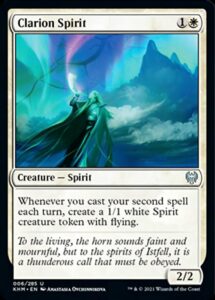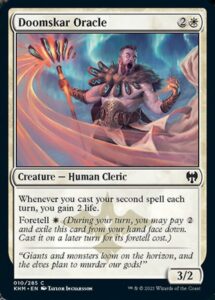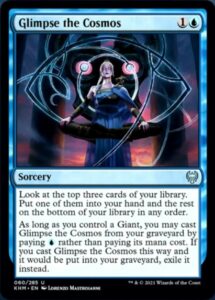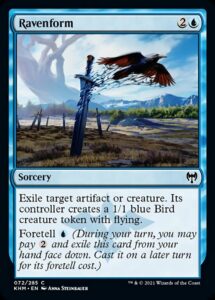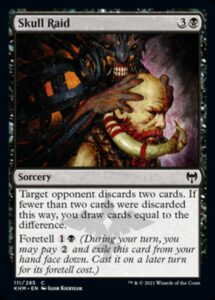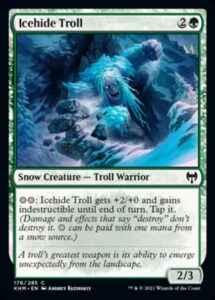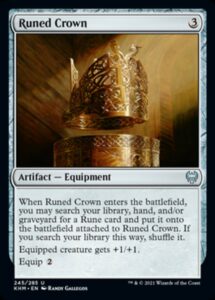Kaldheim is out, and it’s one of the more complex Limited formats this side of Modern Horizons. The majority of its tribal interactions are niche; even the two biggest tribes, elves and giants, will sometimes but not always reward wizards, berserkers, warriors, instants, and sorceries. It features an incredibly powerful mana-smoothing mechanic in Foretell and a swingy aggressive mechanic in Boast. It is exceptionally powerful, featuring outstanding removal and common threats strong enough to demand responses.
I’ve been trying to take things a bit slowly to avoid burnout, so I’m only about ten drafts in so far. That’s enough to learn quite a bit about how draft works, but not enough to draw sweeping conclusions about pick orders and color breaks. Today, let’s focus on some of the most surprising commons and uncommons—the ones that fell far short of expectations and those that overperformed the most.
First Second Easy, Second Second Too Hard
Foretell makes it easy to cast two spells in a single turn—once on turn four, maybe turn three with a Codespell Cleric. But a single trigger of Clarion Spirit isn’t that impressive, and triggering it more than once requires quite the time and resource investment. Clarion Spirit wants to come down on turn 2, the exact turn you want to Foretell an Augury Raven or Iron Verdict. The payoff isn’t good enough to justify playing cheap cards like Usher of the Fallen off curve or putting Codespell Cleric into your deck. I love the look of Clarion Spirit, but it’s been on par with Beskir Shieldmate rather than the second coming of Steward of Solidarity.
Easy Come, Easy Go
I expected Doomskar Oracle to be a replacement-level curve filler—something that wouldn’t make your deck all that often. In practice, Doomskar Oracle has been an annoyingly big threat and a real lifesaver. The cheap Foretell costs means Doomskar Oracle is almost guaranteed to trigger the turn you play it. Its acceptable stats make it a decent threat and its unexciting ability makes it a low priority target as it stealthily gains you 4 life. I’m not saying it’s a high pick, but I’ve seen several games swung away from defeat all because he turned Behold the Multiverse into Sphinx’s Insight.
Dig Through Time is back!
There were questions last week about whether Glimpse the Cosmos or Behold the Multiverse were the better card. Behold is instant-speed, doesn’t hinge on having a board presence, and always works. Glimpse the Cosmos doesn’t have that many U/R giants or G/U changelings to work with (heck, even its own artwork doesn’t have a giant), so it looked more like a Constructed card with limited Limited applications.
Instead, it is disgustingly powerful. It’s not hard to have a single giant, nor is it to spend 1UU to draw two cards from your top six. That’s Dig Through Time levels of card selection. Sure, you get to be a little sad if you draw a clump of three spells followed by a clump of three lands, but more often than not you’ll be burying your opponent in card advantage and card quality.
This Card is Always Bad
Kasmina’s Transmutation, Frogify, and Ravenform are card disadvantage. Sure, they downgrade your opponent’s threat into something manageable, but you’re down a card while your opponent gains something to sacrifice, go wide with, or just attack you with. Ichthyomorphosis, one of the best expressions of this effect (at common), overperformed in Theros Beyond Death as it enabled Constellation and cleared the skies for your fliers. Ravenform darkens the skies for your Augury Ravens, slowing you down and giving your opponent a chance to catch up.
I’m not saying Ravenform is unplayable—exiling is one of the few answers to Koma, Cosmos Serpent—but there is so much quality removal in Kaldheim that this should be a card you begrudgingly play a single copy of, not a card you pick highly.
Always Effective, Usually Frustrating
Four mana Mind Rot effects tend to be sideboard material—the extra mana cost almost always weakens the card more than its bonus strengthens it. The odds seemed especially stacked against Skull Raid given that Foretell makes it facile to keep safe many of your best cards. However, I’ve been gotten by Skull Raid in nearly every draft I’ve played. The only true way to beat it is to have two useless lands in hand, but that’s easier said than done. The uncommon spell lands encourage you to hit every land drop, as do powerhouse cards like Behold the Multiverse and Sarulf’s Packmate, and you rarely are happy discarding snow lands.
I’m not sure whether decks want more than one copy of this effect (it’s no Rakshasa’s Secret), but it’s gone from being a minor concern to a serious annoyance in my book.
Such a Troll
We’re skipping red entirely and moving on to one of the most annoying commons in the format. Green has Sarulf’s Packmate, which is quite likely the best common, and Struggle for Skemfar, an incredibly strong removal spell (that, in a pleasant artistic twist for a removal spell, seems more romantic than violent). In addition, it has Icehide Troll, an incredibly unassuming card that is utterly unstoppable if you have enough snow lands and your opponent has the wrong removal.
I still wouldn’t call Icehide Troll a high pick—green has far easier and more overtly powerful commons—but an unkillable Fireball creature would’ve been uncommon not too long ago. This is the kind of card that’ll make me grab Ravenform from my sideboard if I’m playing too slow of a deck and is worth being afraid of when your opponent is playing green and snow lands.
An Archetype Runed
When Rune was first spoiled as a card type, one imagined they could be as impactful as the Cartouches (and Trials) of Amonkhet. They are not. Not only is each Rune weaker than its Cartouche equivalent, but they’re all uncommon, so they’re rarely numerous enough to build around. They’re at their best when put on equipment, but the high quality uncommon equipment like Draugr’s Helm and Dwarven Hammer reward you for waiting to play them until they can become Living Weapons—further delaying when you can play your Runes to maximum effect. There just isn’t enough equipment to pay off Runes. I wish Runes had some presence at common—sure, slapping four of them onto a Goldvein Pick probably wouldn’t be a game-winning move, but it’d at least be a feasible achievement players could shoot for. As is, I worry that they’re yet another mini-mechanic is a set absolutely chock full of complexity.
And also, why isn’t there an axe in draft boosters? It’s rather odd to build a set around vikings and equipment but have the only axe hidden away in theme boosters. Kind of runes the experience—well, not for Bearded Axe, anyway.
And that’s it for this week. I stuck to cards that played much differently than anticipated, rather than cards that looked awesome and were instead insane (see: Aegar, the Freezing Flame). Honorable mention goes to Masked Vandal, yet another common that provides card advantage for minimal cost, but it already looked solid to me when spoiled. Here’s hoping you’re enjoying the set—there’s a ton to explore and a lot of on-board tricks to avoid (see: Aegar, the Freezing Flame). And, as always, thanks for reading.
Zachary Barash is a New York City-based game designer and the commissioner of Team Draft League. He designs for Kingdom Death: Monster, has a Game Design MFA from the NYU Game Center, and does freelance game design. When the stars align, he streams Magic (but the stars align way less often than he’d like).

